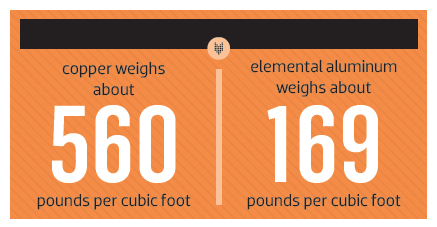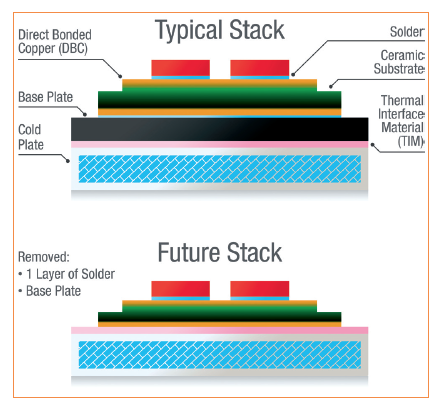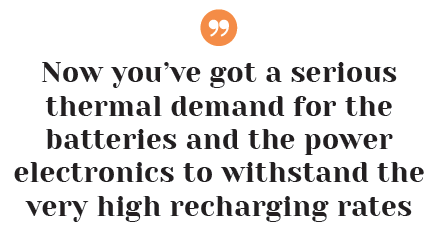In 1982, the US Mint made the practical decision to change the composition of the penny coin from 95% copper/5% zinc – an alloy you know as brass – to 97.5% zinc with copper plating. Inflation had pushed the price of copper in a penny above one cent, and zinc was significantly less expensive and noticeably lighter. More than 30 years later, it cost the US Mint about 1.7 cents to produce each penny in 2014, and because the government has shown reluctance to discontinue the penny, perhaps it should move on to an even less expensive and much lighter metal: aluminum.
While zinc weighs about 20% less than copper (445 lb/ft3 compared to 560 lb/ft3), elemental aluminum weighs only 169 lb/ft3 – about 70% less than copper. It may make little sense for your pocket change to be that light, but in hybrid and electric vehicle engine and battery cooling systems, such a major weight reduction can literally go a long way in extending the vehicle’s range. There’s also a significant price differential for aluminum. Metal prices constantly shift, but as of May, aluminum was trading at less than a third the price of copper: $0.78/lb, compared to $2.81/lb.


Those are two significant reasons why one of the largest independent suppliers to global light, commercial and industrial vehicle manufacturers, Maumee, Ohio’s Dana Holding, is also one of the first to design and now manufacture completely aluminum cooling solutions for hybrid and electric vehicles.
Aluminum heating up
Dana’s origins stretch all the way back to 1904, and today it employs more than 23,000 people in dozens of locations in 25 countries. It has more than 3,000 OEM and aftermarket customers for its axles, driveshafts, transmissions, fuel cell components, sealing and thermal management products.
The company’s new aluminum cooling system is a continuation of its established Long line of thermal products, which have traditionally employed copper in the past. The new aluminum array of compact products can address the demanding space requirements of PHEVs and EVs, and includes a battery cooling chiller, integral battery cooling plate, electronic cooling plate, stator cooler, engine control unit cooler and sub-cooled loop radiator. Dana leverages its existing Long process technology for the new aluminum products, and offers custom-tailored parts to meet each customer’s specifications.
There’s been a special emphasis on the aluminum integrated cooling plates, which begin production this year at Dana’s manufacturing facility in Cambridge, Ontario. These plates remove trapped heat and minimize the temperature of insulated gate bipolar transistor (IGBT) switch junctions. They also take advantage of Dana’s proprietary fluxless brazing process, which produces minimal coolant contamination for maintaining low conductivity in the power electronics cooling circuit.
IGBT power modules mount on top of the cooling plates, and then liquid flows through them. “Power electronics engineers are looking for extremely flat mounting surfaces on the coolers, to ensure maximum contact with the mechanically mounted IGBT dies,” said Nick Kalman, Technical Business Development Manager for Dana’s Power Technologies Group. “That way you minimize thermal resistance and enable a high rate of heat transfer between the actual electronic device and the heat exchanger.”
Kalman is in his 21st year with Dana and works out of the company’s research and development location in Oakville, near Toronto and just about an hour’s drive from Dana’s aluminum cooling plate factory. Dana started developing products for hybrid and electric vehicles about 15 years ago, and Kalman said that the increasing peak power loads due to higher recharging rates and regenerative braking are driving today’s thermal management designs.
“It’s not just the discharge of the battery during demanding operating conditions,” he said. “Now you’ve got a serious thermal demand for the batteries and the power electronics to withstand the very high recharging rates – whether it’s regen braking or a stationary charge.”
Flux-free
Because of the higher standards its customers expect, Dana is introducing innovations into its aluminum cooling components. It has a proprietary trick up its sleeve: a flux-free aluminum brazing process. Whereas some other heat exchanger manufacturers use a flux brazing process, which leaves a residue on the aluminum’s surface, Dana’s fluxless continuous process efficiently delivers precision parts without residue or contaminants.
“For any type of a high-voltage system, whether it’s an electric, hybrid or fuel cell vehicle,” Kalman said, “you want to reduce the ions and contaminants in the cooling fluid stream to minimize any potential stray voltage or any potential conductivity there.”
In a flux brazed system, it may be necessary to use polishing filters to scrub out any ions that may be streaming through contaminated coolant, in order to avoid problems from sending potentially conductive coolant through power electronics. The cleaner brazed parts require no secondary cleaning operations, and reduce the chance of contaminated coolants, “so there’s a lot less to worry about for our OEM coolant system packager customers,” Kalman said. “They don’t have to worry about all the ions and flux residues in the heat exchangers.”
Ironing out aluminum
There’s a good reason that copper was the gold standard for heat transfer metals for so long. It’s still superior to aluminum for pure heat exchange. While aluminum provides a cost-effective, lightweight and highly recyclable solution, Dana cannot simply use the same copper designs of the past, replace the metal with aluminum and expect the same results.
Part of making aluminum cooling plates comparable to copper requires the aluminum to be especially flat, because of the close contact required of the IGBT device. Dana’s aluminum cooling plates provide the foundation for the IGBT stack. Starting with the thermal interface material (TIM), layers of solder, ceramics, and direct-bonded copper (DBC) attach the die to the aluminum cooling plate.
“Keeping our surface really flat enables you to reduce the amount of TIM in there, and optimize your heat transfer rate,” Kalman said. “With aluminum, you need that thermal resistance to be as low as possible, so the flatness is really critical. On top of that, with aluminum, you’re dealing with a material that’s a bit less conductive, so all those little stack-ups and fit-ups are very important.”
Dana has a couple of ways to ensure its aluminum cooling plates’ flatness, depending on the specific requirements of the custom-made pieces. Its process produces flat parts without the need for post operations, and it has an end-of-line check using a coordinate-measuring machine to make sure it hits the flatness target.
“Again, Dana’s continuous fluxless brazing process delivers very flat and clean surfaces,” said Kalman.
An even cooler future
As peak power demands for hybrid and electric vehicles increase, Dana’s thermal product customers would like to know that their products will last the lifetime of the vehicle without being subject to failure. So to prepare for the increasing loads, Dana is already working on some improvements for its next generation Long aluminum cooling system.
For one thing, the company is working on reducing the number of layers in the IGBT stack. “We want to take out the thermal interface material and replace that by direct-bonding your IGBT devices directly onto your heat exchangers,” Kalman said. “If you can eliminate the TIM, which is the majority of thermal resistance, now you’re talking about much higher performance.”


The next generation of Dana cooling plates will have a higher level of integration with the IGBT die. “Taking out resistive layers lets you dissipate the heat into the heat exchanger a lot faster,” Kalman said. “That enables the power electronics engineers to build higher-performing and smaller IGBT chips that will still be thermally controlled and avoid the types of failures you’ve seen in the past.”
Those smaller IGBT chips may also need to be reconfigured to be able to be cooled on both sides, because Dana is gearing up for what it calls dual-sided cooling, in which the IGBT die would be sandwiched between two heat exchangers on either side. “There’s so much heat flux inside these junctions that they need solutions that can mount on both surfaces of the IGBT,” Kalman said.


It will take some engineering trickery to have two fluid connections between the cooling plates and the IGBTs, and yet still handle the thermal expansions and contractions from the heat over the lifetime of the vehicle. Successful implementation will pay off in higher peak power capability and longer life.
“It enables [customers] to package compact high-power chips they prefer, by cooling them on both sides,” Kalman said. “In terms of a direct-bonded or integrated solution, where you can eliminate the thermal interface material, we’re aiming for performance measures that will be at least 30% or more.”
This article originally appeared in Charged Issue 19 – May/June 2015.





















































